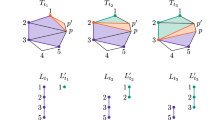Abstract
We shall show that on the average, the total length of a Delaunay triangulation is of the same order as that of a minimum triangulation, under the assumption that our points are drawn from a homogeneous planar Poisson point distribution.
Similar content being viewed by others
References
J. L. Bentley,Multidimensional divide-and-conquer, Communications of ACM, Vol. 23, No. 4 (1980), 214–229.
R. C. Chang and R. C. T. Lee,The average case performance analysis of Bentley's divide-and-conquer algorithm to solve the planar closest-pair problem, to appear.
B. Delaunay,Sur la sphere vide, Bull. Acad. Sci. USSR(VII), Classe Sci. Mat. Nat. (1943), 793–800.
J. R. Goldman,Stochastic point process: limit theorems, Ann. Math. Statist. 38 (1967), 771–779.
D. G. Kirkpatrick,A note on Delaunay and optimal triangulations, Information Processing Letters, Vol. 10, No. 3 (1980), 127–128.
C. L. Lawson,Software for C 1 surface interpolation, inMathematical Software III, J. Rice, Ed., Academic Press, New York (1977).
D. T. Lee and B. J. Schachter,Two algorithms for constructing a Delaunay triangulation, International Journal of Computer and Information Sciences, Vol. 9, No. 3 (1980), 219–242.
A. Lingas,Advances in Minimum Weight Triangulation, Dissertation, Linköping University, Sweden (1983).
E. L. Lloyd,On triangulations of a set of points in the plane, Proc. 18th Annual IEEE Conference on the Foundations of Computer Science, Providence (1977).
G. K. Manacher and A. L. Zorbrist,Neither the greedy nor the Delaunay triangulation of a planar point set approximates the optimal triangulation, Information Processing Letters, Vol. 9, No. 1 (1979), 31–34.
E. S. Marks,A lower bound for the expected travel among m random points, Ann. Math. Statist. 19 (1948), 419–422.
R. E. Miles,On the homogeneous planar Poisson point process, Mathematical Biosciences, Vol. 6 (1972), 85–127.
M. I. Shamos,Geometry and Statistics: Problems at the interface, inAlgorithms and Complexity: New Direction and Recent Results, J. F. Traub, Ed., Academic Press, New York (1976).
M. I. Shamos,Computational Geometry, Ph.D. Dissertation, Yale University (1978).
M. I. Shamos and D. Hoey,Closest point problems, Proc. 16th Annual IEEE Conference on Foundations of Computer Sciences (1975), 151–162.
G. Voronoi,Nouvelles applications des parametres continus a la theorie des formes quadratiques. Deuxieme Memoire:Recherches sur les parallelloedres. Deuxieme reine angew. Math. 134 (1908), 198–287.
Author information
Authors and Affiliations
Rights and permissions
About this article
Cite this article
Chang, R.C., Lee, R.C.T. On the average length of Delaunay triangulations. BIT 24, 269–273 (1984). https://doi.org/10.1007/BF02136025
Received:
Revised:
Issue Date:
DOI: https://doi.org/10.1007/BF02136025




